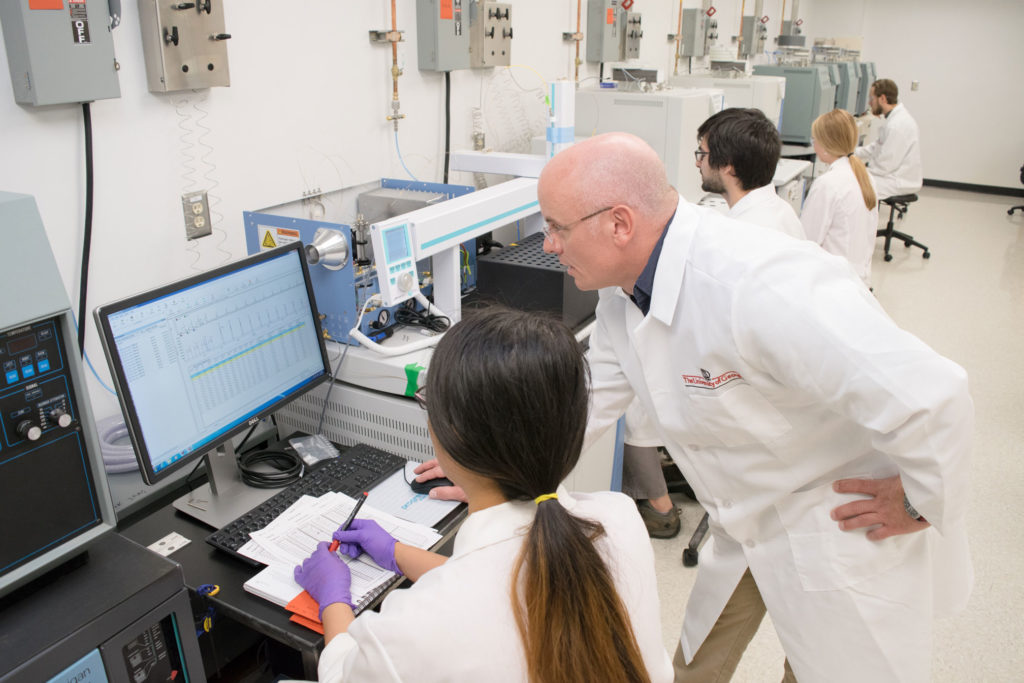Athens, Ga. — The Center for Applied Isotope Studies at the University of Georgia is already world-renowned, but the center’s role in the scientific community just became even bigger.
Following an expansion of the facility on Riverbend Road and acquisition of new instrumentation, the 24,000-square-foot center is now home to the largest stable isotope lab in North America, surpassing the University of California, Davis, and cementing its position as an industry leader.
Stable isotope analysis, which is the focus of the latest lab expansion, is the measurement of carbon, nitrogen, oxygen, deuterium and sulfur isotopic signatures in environmental and biological samples. It can be used to track everything from animal migration patterns and ocean temperatures to helping reconstruct ecosystems, monitoring pollution or testing products.
“We’re rebuilding and reimagining this center into something that I believe is truly phenomenal — as a whole, there’s no place like this in the entire United States,” said Jeff Speakman, director of CAIS. “Many smaller labs struggle because they are not able to reinvest in the latest and greatest technology, so being able to continue to invest into new instrumentation is key to staying ahead of the game.”
The center, which operates under the Office of Research, was founded in 1968 and is home to one of the oldest radiocarbon and stable isotope laboratories in the world. Today 12 full-time scientists and 13 technical staff provide analytical services, conduct research and engage in teaching students from a variety of disciplines.
In addition to the stable isotope lab expansion, the center has ramped up STEM education outreach, added several powerful new instruments and achieved two distinguished recognitions: accreditation for the radiocarbon and stable isotope labs and certification for the bio-based testing lab.
The center’s recent accreditation to conduct stable isotope and radiocarbon analyses under the International Organization for Standardization, ISO/IEC 17025:2005, is recognized universally as the highest level of quality attainable by a testing laboratory, and the ASTM International certification makes the center home to one of two laboratories in the U.S. certified to determine whether bio-based products meet USDA standards.
Industry partners, universities, government agencies and researchers across the world rely on CAIS analyses for studies in ecology, chemistry, biology, anthropology, marine science, geology, physics, plant science, horticulture and forestry.
“The growth in demand for services has allowed us to reinvest into the facility, and that ultimately allows us to give students more opportunities to conduct research and engage the researchers at UGA,” said Speakman, who came to UGA from the Smithsonian Institution in 2011.
In addition to stable isotope analysis, the center houses laboratories for radiocarbon dating, bio-based product testing, elemental analysis, natural product authenticity, and organic and inorganic analyses. Last year CAIS analyzed approximately 68,000 samples; the stable isotope lab processed about 75 percent of those samples.
Additions to the new lab include three isotope ratio mass spectrometers and two flash elemental analyzers made by Thermo Scientific, which measure the isotopes, and two gas benches used to prepare the samples. In total, the center maintains 17 instruments capable of measuring stable isotopes of carbon, nitrogen, hydrogen and oxygen.
“The new gas bench is going to open up all kinds of possibilities,” said Tom Maddox, staff scientist and manager of the stable isotope laboratory. “Now you can process hundreds and hundreds of samples and it’s super effective, convenient and incredibly accurate — within minutes you have your answer.”
Maddox brings more than 23 years of ecology and stable isotope expertise to the lab, and in addition to his role as manager, guides students through the sample process.
Kathy Loftis, assistant research scientist at CAIS, has watched the center grow in size and student involvement since 2008, when she began using the lab to conduct research for her doctorate in marine science.
“These instruments are incredibly expensive and can be difficult to manage, and so they’re not readily available, much less to students. I would come in here and run my own samples, which was instrumental in my career and allowed me to build myself up as an analytical chemist,” Loftis said.
Speakman noted that while providing services to outside clients is important, helping UGA researchers is one of CAIS’ primary goals. “We want to work with students, we want to work with the faculty and we want to be an integral part of research at UGA.”
Find out more at cais.uga.edu.
